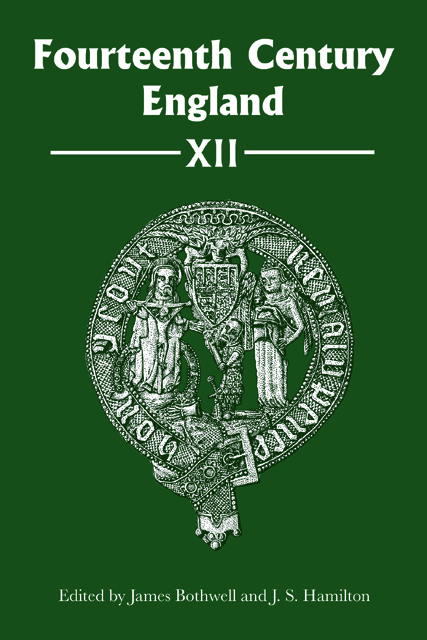Book contents
- Frontmatter
- Contents
- List of Illustrations
- List of Contributors
- Preface
- Abbreviations
- The King’s Confessors and the Royal Conscience in Late Medieval England
- ‘Such maintenance as …’: Corrodies of the Crown
- ‘Vos maisons sount pris al eops le counte’: Walter Bedwyn, Treasurer of York, and the Return of Piers Gaveston
- The Deposition of Edward II: The Kenilworth Embassies
- The English Parliament and the Trial of the ‘Peers of the Land’ in Henry of Lancaster’s Revolt (1328–29): The Origins of a Privilege
- A Brotherhood Uncovered: Investigating the Knightly Following of Thomas Beauchamp, earl of Warwick, 1329–69
- The Black Death and Clerical Prospects in England
- The Last of the Duketti? Richard II, Henry of Monmouth and the House of Lancaster
- Confusion Confounded? The Contrasting Military Fortunes of Sir William Neville (d. c.1391) and Sir William Neville of Pickhill and Rolleston (d. c.1420)
The Last of the Duketti? Richard II, Henry of Monmouth and the House of Lancaster
Published online by Cambridge University Press: 11 January 2023
- Frontmatter
- Contents
- List of Illustrations
- List of Contributors
- Preface
- Abbreviations
- The King’s Confessors and the Royal Conscience in Late Medieval England
- ‘Such maintenance as …’: Corrodies of the Crown
- ‘Vos maisons sount pris al eops le counte’: Walter Bedwyn, Treasurer of York, and the Return of Piers Gaveston
- The Deposition of Edward II: The Kenilworth Embassies
- The English Parliament and the Trial of the ‘Peers of the Land’ in Henry of Lancaster’s Revolt (1328–29): The Origins of a Privilege
- A Brotherhood Uncovered: Investigating the Knightly Following of Thomas Beauchamp, earl of Warwick, 1329–69
- The Black Death and Clerical Prospects in England
- The Last of the Duketti? Richard II, Henry of Monmouth and the House of Lancaster
- Confusion Confounded? The Contrasting Military Fortunes of Sir William Neville (d. c.1391) and Sir William Neville of Pickhill and Rolleston (d. c.1420)
Summary
The deposition of Richard II in 1399 was a central political event of late fourteenth century England, and perhaps the most significant political act in late medieval England overall. In 1993, Chris Given-Wilson described Richard’s deposition as ‘vigorously debated’ and noted that ‘that debate has never shown signs of slackening’. Yet, a leading interpretation of the deposition has tended to remain constant in fourteenth century historiography: Richard was deposed because he made himself an enemy of the house of Lancaster through his seizure of the Lancastrian estates on the death of John of Gaunt, dispossessing his exiled cousin, Henry Bolingbroke. Further, Richard extended Bolingbroke’s exile from ten years to life. These two acts impelled Bolingbroke to return to England and allowed him to appear as the champion of justice against a Ricardian regime perceived as inconstant and tyrannical. Bolingbroke’s return resulted in Richard’s deposition in September 1399 and his death in February 1400. Richard II’s actions towards the house of Lancaster, therefore, spark two questions for consideration. First, what rationale motivated Richard to commit these flagrant acts of royal will against Bolingbroke? Second, what were his ultimate intentions regarding the house of Lancaster in 1399?
Given-Wilson advanced an argument in 1994 seeking to answer these questions. He argued that Richard II’s seizure of the Lancastrian estates and his perpetual banishment of Henry Bolingbroke were an attempt to destroy the house of Lancaster so as to restore the majesty and power of the crown. Given-Wilson stressed how Richard was looking back to the reign of his great-grandfather, Edward II. Richard II cultivated an interest in Edward II’s reign early on, perhaps seeing his ancestor as a king beset by the machinations of treacherous magnates in a similar manner that he believed himself to be. Throughout the 1390s, Richard sponsored the canonization of Edward II as a martyr for the rights of the crown in a move devised to enhance his own regality as well. The king’s fascination and probable identification with Edward II can still be glimpsed at the latter’s tomb in Gloucester cathedral: Richard II ordered white harts, his personal badge, to be painted on the pillars on either side of the tomb chest in 1378.
- Type
- Chapter
- Information
- Fourteenth Century England XII , pp. 151 - 178Publisher: Boydell & BrewerPrint publication year: 2022



